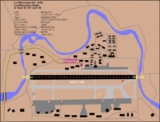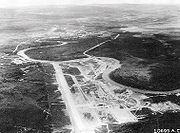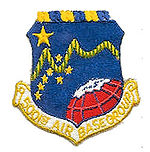
Ladd Field
Encyclopedia



Fort Wainwright
Fort Wainwright is a United States Army post adjacent to Fairbanks in the U.S. state of Alaska. It is part of the Fairbanks, Alaska Metropolitan Statistical Area.-History:...
, located in Fairbanks, Alaska
Fairbanks, Alaska
Fairbanks is a home rule city in and the borough seat of the Fairbanks North Star Borough in the U.S. state of Alaska.Fairbanks is the largest city in the Interior region of Alaska, and second largest in the state behind Anchorage...
. It was originally called Fairbanks Air Base, but was renamed Ladd Field on 1 December 1939, in honor of Major Arthur K. Ladd, a pilot in the U.S. Army Air Corps who died in a plane crash near Dale, South Carolina on 13 December 1935.
Origins
The U.S. government began, for the first time, serious infrastructure expenditures in AlaskaAlaska
Alaska is the largest state in the United States by area. It is situated in the northwest extremity of the North American continent, with Canada to the east, the Arctic Ocean to the north, and the Pacific Ocean to the west and south, with Russia further west across the Bering Strait...
during the 1930s. Most prominent was an increase in the military presence. For most of the early 20th century, the only Army post in Alaska was Chilkoot Barracks/Fort Seward
Fort William H. Seward
Fort William H. Seward, also known as Chilkoot Barracks or as AHRS Site No. SKG-001 is a site at Port Chilkoot in Haines, Alaska. It was the last of a series of 11 military posts established in Alaska during the gold rush era....
, located just outside of Haines
Haines, Alaska
Haines is a census-designated place in Haines Borough, Alaska, United States. As of the 2000 census, the population of the area was 1,811. Haines was formerly a city but no longer has a municipal government...
. With the threat of war looming as the 1930s ended, the need was established to develop multiple facilities as a means of defending Alaska against possible enemy attack.
The U.S. government acquired homesteads southeast of the town of Fairbanks beginning in 1938. From this land, totalling about 6 square miles (15.5 km²), was created Ladd Field. The first aircraft to land at Ladd was Douglas O-38F
Douglas O-38
-References:*The complete Encyclopedia of World Aircraft Editors: Paul Eden & Soph Moeng, , 1152 pp.-External links:...
, 33-324, c/n 1177, in October 1940, which is now preserved in the National Museum of the United States Air Force
National Museum of the United States Air Force
The National Museum of the United States Air Force is the official museum of the United States Air Force located at Wright-Patterson Air Force Base northeast of Dayton, Ohio. The NMUSAF is the world's largest and oldest military aviation museum with more than 360 aircraft and missiles on display...
. Major construction of facilities began in 1941 and 1942, after the U.S. entered World War II
World War II
World War II, or the Second World War , was a global conflict lasting from 1939 to 1945, involving most of the world's nations—including all of the great powers—eventually forming two opposing military alliances: the Allies and the Axis...
. The initial construction occurred several miles from Fairbanks along a bend of the Chena River, consisting of an airfield, hangars, housing and support buildings. Many of these buildings still stand today.
Alaska's transportation infrastructure at the time was so limited and the problem of military supply so acute, it also made sense to concentrate the bases along existing supply lines near Anchorage and Fairbanks
Fairbanks
Fairbanks may refer to:Places in the United States*Fairbanks, Alaska, city*Fairbanks, California, unincorporated community in El Dorado County*Fairbanks, Mendocino County, California, former settlement*Fairbanks, Indiana, unincorporated community...
. Ladd's location near Fairbanks, the Richardson Highway and the Alaska Railroad, its access to fuel from the CANOL pipeline, and its position at the time as one of the United States' northernmost developed airbases were important factors in securing its early Cold War prominence.
The major use of Ladd Field was primarily cold-weather testing of aircraft and equipment. Only Interior Alaska offered the consistently cold temperatures needed. However, the Attack on Pearl Harbor
Attack on Pearl Harbor
The attack on Pearl Harbor was a surprise military strike conducted by the Imperial Japanese Navy against the United States naval base at Pearl Harbor, Hawaii, on the morning of December 7, 1941...
in December 1941 forced the temporary halt on testing at Ladd since the military needed all aircraft for the defense of Alaska.
World War II
Testing at Ladd Field began again in 1942, but by 1943 aircraft cold-weather testing had become a second priority, as Ladd became the hub for fighters and bombers destined for the "Forgotten 1,000 Mile War" in the Aleutians against the Japanese or on their way to Soviet forces as part of the Lend-Lease program.Reflecting the need to insure aircraft bound for the Soviet Union were prepared for the flight to Galena and Nome, prior to flying across the Bering Straits to Siberia, Ladd AAF the Air Technical Service Command 11th ASC Depot Wing was activated and the Alaska Air Depot was established on 8 July 1942.
The airplanes arrived at Ladd were stripped of all but basic instrumentation and armament. Flights took off with no navigational aids from Ladd Field and fly the first leg to Galena
Galena
Galena is the natural mineral form of lead sulfide. It is the most important lead ore mineral.Galena is one of the most abundant and widely distributed sulfide minerals. It crystallizes in the cubic crystal system often showing octahedral forms...
on the Yukon River
Yukon River
The Yukon River is a major watercourse of northwestern North America. The source of the river is located in British Columbia, Canada. The next portion lies in, and gives its name to Yukon Territory. The lower half of the river lies in the U.S. state of Alaska. The river is long and empties into...
. After refueling they went on to Nome
Nome
Nome may refer to:A country subdivision:* Nome an administrative division within ancient Egypt.* Nome , the administrative division immediately below the peripheries of Greece Places:* Nome, Norway* Nome, Alaska, US...
, for the short hop across the Bering Strait
Bering Strait
The Bering Strait , known to natives as Imakpik, is a sea strait between Cape Dezhnev, Chukotka Autonomous Okrug, Russia, the easternmost point of the Asian continent and Cape Prince of Wales, Alaska, USA, the westernmost point of the North American continent, with latitude of about 65°40'N,...
to Siberia
Siberia
Siberia is an extensive region constituting almost all of Northern Asia. Comprising the central and eastern portion of the Russian Federation, it was part of the Soviet Union from its beginning, as its predecessor states, the Tsardom of Russia and the Russian Empire, conquered it during the 16th...
. Many were lost because of bad weather. The weather was also a danger to the ferrying of aircraft into Fairbanks
Fairbanks
Fairbanks may refer to:Places in the United States*Fairbanks, Alaska, city*Fairbanks, California, unincorporated community in El Dorado County*Fairbanks, Mendocino County, California, former settlement*Fairbanks, Indiana, unincorporated community...
.
Ice fog became a problem for airplanes landing at the field. The airplanes coming in from Great Falls AAB, Montana
Montana
Montana is a state in the Western United States. The western third of Montana contains numerous mountain ranges. Smaller, "island ranges" are found in the central third of the state, for a total of 77 named ranges of the Rocky Mountains. This geographical fact is reflected in the state's name,...
often could not make it to Ladd. Worse, many didn’t have enough fuel to make it back to Big Delta (to use the alternate Allen Field). It was this danger that led to the military decision to build an auxiliary field south of Ladd Field for a weather-alternate which eventually became "26 Mile Field", and later, Eielson Air Force Base
Eielson Air Force Base
Eielson Air Force Base is a United States Air Force base located approximately southeast of Fairbanks, Alaska and just southeast of Moose Creek, Alaska....
.
By the end of the war, 7,926 aircraft were ferried though Ladd Field. The last aircraft transited the airfield on 1 September 1945.
When the Air Force was made a separate branch in 1947 the name was changed to Ladd Air Force Base. For many years, it would be one of two Air Force bases in the Fairbanks area.
Cold War
- see also: 5001st Composite Wing5001st Composite WingThe 5001st Composite Wing is an inactive United States Air Force organization. Throughout its existence, it was assigned to the Alaskan Air Command and stationed at Ladd Air Force Base, Alaska....
From the late 1940s into the 1950s, Ladd AFB served as the northern hub for Air Force activities in Alaska. As headquarters first of the Northern Sector of the Alaskan Air Command
Alaskan Air Command
Alaskan Air Command is an inactive United States Air Force Major Command. Established in 1945 under the United States Army Air Forces, its mission was to organize and administer the air defense system of Alaska, exercise direct control of all active measures, and coordinate all passive means of...
and later of the 11th Air Division, Ladd was centrally involved in the Cold War missions of the Alaskan Command and in the transient missions of other military units, including the Strategic Air Command
Strategic Air Command
The Strategic Air Command was both a Major Command of the United States Air Force and a "specified command" of the United States Department of Defense. SAC was the operational establishment in charge of America's land-based strategic bomber aircraft and land-based intercontinental ballistic...
(SAC).
Known units assigned to Ladd AFB were:
- 11th Air Division, 1 November 1950-27 April 1951; 27 April-20 July 1951; 8 April 1953-25 August 1960.
- 18th Fighter Squadron, June 20 – August 15, 1946
- 433d Fighter-Interceptor Squadron, (ADC) 16 July 1954-1 November 1957
- 449th Fighter Squadron (various designations), 28 March 1949-25 August 1960
Ladd was not exclusively an Air Force site. The Army was also present to provide antiaircraft (AAA) support and base defense. At Ladd, Cold War activities fell mainly into three time periods: an early phase from 1946–1950; a buildup and support hub phase from 1950–1957; and a transfer phase from 1958–1961, when the installation was turned over to the Army.
During 1946-1950, personnel from Ladd laid some of the groundwork of the early Cold War with strategic reconnaissance and Arctic research projects. Among other missions, they made initial assessments of the Soviet presence in the Arctic; more fully developed the practice of polar navigation; extended Arctic topography; tested cold weather equipment, clothing, and human performance, as well as maintained the area air defenses of the region.
In 1948, as Cold War tensions heightened, the Army's 2nd Infantry sent ground defense soldiers to Ladd
From the onset of the Korean War in 1950 and continuing through 1957, Ladd saw intense use. It became a busy operations and logistics center with significantly expanded facilities and personnel strength.
As the northern region headquarters of the 11th Air Division, the base was the logistical support center for Alaska's new defense projects. Ladd supported Aircraft Control & Warning (AC&W) sites and forward operating bases such as Galena
Galena
Galena is the natural mineral form of lead sulfide. It is the most important lead ore mineral.Galena is one of the most abundant and widely distributed sulfide minerals. It crystallizes in the cubic crystal system often showing octahedral forms...
, the northwestern segments of the Distant Early Warning Line
Distant Early Warning Line
The Distant Early Warning Line, also known as the DEW Line or Early Warning Line, was a system of radar stations in the far northern Arctic region of Canada, with additional stations along the North Coast and Aleutian Islands of Alaska, in addition to the Faroe Islands, Greenland, and Iceland...
(DEW Line), and the White Alice communications network (WACS).
Research projects grew from early Arctic aeromedicine and cold weather testing to include ice station research on the polar pack ice and support for Air Force contracted research in geophysics, communications, and other disciplines. Air defense remained the primary combat mission, while tactical ground support, fighter escort, Arctic training exercises, and base defense were other parts of the base's integrated combat role. The 4th Infantry supplied the Army manpower through 1956.
After 1957, several developments affected Ladd's mission. The technologies of warfare, communications, and reconnaissance had changed. Intercontinental ballistic missiles (ICBMs) and satellites would eventually mean a smaller role for AC&W units, the DEW line, and land-based communications such as White Alice. In 1958, substantial budget reductions forced commanders to reassess their resources. Near Fairbanks, two major air bases, Eielson and Ladd, existed less than thirty miles apart.
Transfer to United States Army
By 1958, the space age was dawning. ICBMs changed the focus of air defense away from responding to manned bombers, and satellites were poised to revolutionize communications. That year, the Eisenhower administration drastically curtailed defense funding. One year later, in September 1959, USAF Headquarters informed the Alaskan Air Command that Ladd would be closed and its functions transferred to Eielson and Elmendorf AFBs.For some time, the closure plans remained secret. In May 1960, USAF announced that the 449th Fighter Interceptor Squadron
449th Fighter Interceptor Squadron
The 449th Fighter Interceptor Squadron is an inactive United States Air Force unit. Its last assignment was with 11th Air Division stationed at Ladd Air Force Base, Alaska. It was inactivated on August 25, 1960.-History:...
would be deactivated as part of a "recent reevaluation of the Air Defense Master Plan". By September 1960, Air Force flying operations ceased at Ladd, while announcements confirmed that the Army would take over the installation.
By 1960, operations at Ladd had already diminished from the height of activity in the mid 1950s. The last fighter squadron, the 449th, was deactivated in August 1960. Remaining operations included the Arctic Survival Training School, the 55th Weather Squadron and the MATS Beaverette passenger flights to Elmendorf and McChord AFBs. These responsibilities transferred entirely to Eielson. Most other functions transferred to Elmendorf, including a unit of C-123 transport aircraft, Tactical Air Navigation (TACAN) operations, and all logistic support for auxiliary sites. A few operations continued on-site as Army tenants under Air Force control after the transfer, most notably the USAF hospital and the Arctic Aeromedical Laboratory.
The actual transfer operation was an administrative undertaking lasting more than six months. Each Air Force function was scrutinized and either transferred or closed out, with supplies and equipment turned in, inventories zeroed out, and personnel reassigned. Ladd, already the headquarters of the Army's Yukon Command, would see the arrival of 2,000 Army personnel previously stationed at Eielson as part of the transfer.
On January 1, 1961, the Army formally took over the installation and renamed it Fort Wainwright.
It was declared a National Historic Landmark
National Historic Landmark
A National Historic Landmark is a building, site, structure, object, or district, that is officially recognized by the United States government for its historical significance...
in 1985.
External links
- Ladd Army Airfield, Fort Wainwright, Alaska (official site)
- Alaska FAA airport diagram (GIFGIFThe Graphics Interchange Format is a bitmap image format that was introduced by CompuServe in 1987 and has since come into widespread usage on the World Wide Web due to its wide support and portability....
) - Aviation: From Sand Dunes to Sonic Booms, a National Park Service Discover Our Shared Heritage Travel Itinerary
- Ladd Army Airfield at GlobalSecurity.orgGlobalSecurity.orgGlobalSecurity.org, launched in 2000, is a public policy organization focusing on the fields of defense, space exploration, intelligence, weapons of mass destruction and homeland security...

